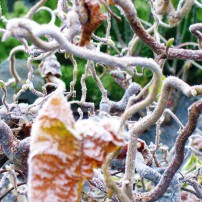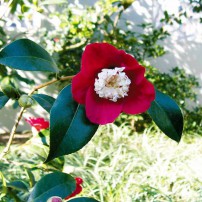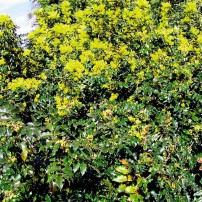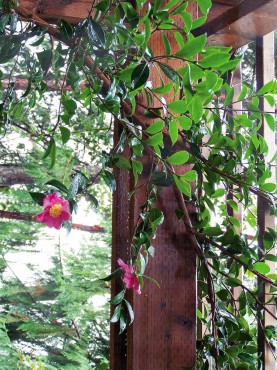
Good garden design shows no bias to seasons; there is something for everyone as the changes mingle and blend. To discover the garden in winter, bundle up and take a walk outside. The season shows the real bone structure and also reveals the nakedness of mixed planting borders that don’t have much to offer after summer’s faded glory.
It is the season where dormancy and decay are the predominate features. Deciduous trees are leafless and perennials have disappeared underground. Take a fresh look at the gray, winter sky as it shows the bare bones of tree silhouettes and powerful evergreens. The evergreens are more noticeable without the competition of peak summer season. As they dominate the forefront, take a look at how to bring a garden of winter interest back into view. The effective use of winter-blooming plants can infuse all seasons of color into the garden.
Plants chosen for interesting blooms, bark, berries and branching habits give the winter garden a whole new appeal. Unexpected color in the midst of a gray winter is the highlight to every garden.
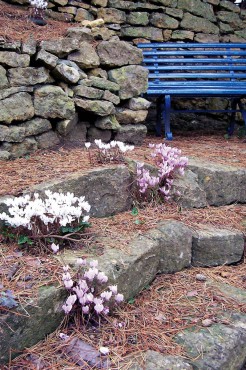
The Bloomers
Witch hazel (Hamamelis sp.)
Popular for its fragrant flowers in the winter, another feature of this plant is its open vase-like habit. The branches zigzag, creating nice branching architecture.
Heaths (Erica sp.)
Often confused with heathers (Calluna), the true heaths are the winter and early spring bloomers. The low-growing mounds create a tapestry of color.
Winter-blooming jasmine (Jasminum nudiflorum)
A vibrant surprise in the midst of winter, the yellow flowers do not have fragrance like other jasmines. Combine it with a summer-blooming deciduous clematis for a year-round blooming, climbing combination.
Oregon grape (Mahonia sp.)
A relative of our native Oregon grape, hybrid cultivars of shrub Mahonia like “Charity” or “Winter Sun” have large, striking blooms with large, dramatic foliage.
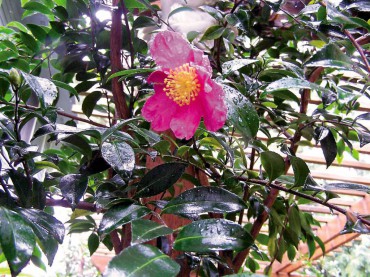
Camellia (Camellia sp.)
An old-fashioned favorite, the Sasanqua varieties are more disease-resistant and show off their explosion of bloom in the winter. From single to double petals, top performers include “Apple Blossom,” “Setsugekka” and the brilliant red of “Yuletide.” Good choice of evergreen for areas in the yard with partial shade.
Sweet box (Sarcococca sp.)
This evergreen shrub is perfect for the shade. Tiny, white flowers hide along the branches in February and emit a powerful fragrance.
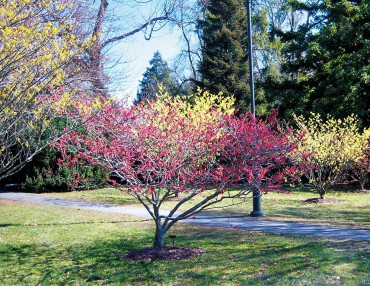
Christmas rose (Hellebore sp.)
The popularity of this plant has surged as more varieties come available. Its common name, Christmas or Lenten rose, reveals its bloom time. Look for the double-petaled ones or long, heavy bloomers like “Ivory Prince.”
Hardy Cyclamen
Sweet tiny flowers top the heart-shaped leaves. C. hederifolium blooms in the late summer to fall and C. coum in late winter.
Crocus and Snowdrops
The classic bulbs that are always photographed peeking up through winter snow. Allow them to naturalize for a winter-blooming carpet under a grove of deciduous trees.
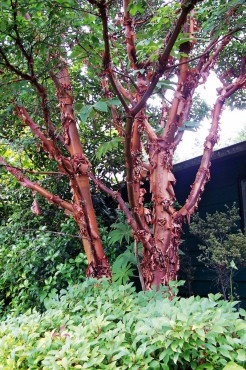
The Trees
Unusual bark or branching habits highlight a winter landscape. Landscape lighting further enhances the effect when placed at the base of trees to silhouette the framework.
Paperbark maple (Acer griseum)
A good tree for small gardens, just as the name implies, it has a cocoa-brown bark that peels off paper-thin.
River birch (Betula nigra)
This shaggy barked tree with large stature is slender and elegant. The variety “Heritage” will begin to peel the bark at a younger age.
White bark birches (Betula sp.)
Really effective as a winter centerpiece in a planting bed or small grove of three, the stark-white bark gives dimension against a backdrop of evergreen trees.
Coral bark maple (Acer p. “Sango Kaku”)
Brilliant, new-growth branches show vibrant color in the winter that makes this Japanese maple a standout. In a grove of evergreens or as a specimen by itself, the leafless silhouette changes to a deep coral color as the weather gets colder.
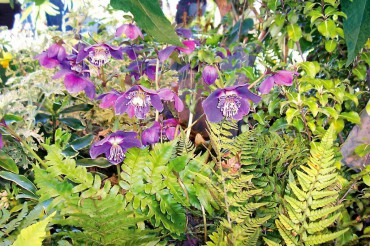
Contorted filbert (Corylus avellana “Contorta”)
Also known as Harry Lauder’s Walking Stick, it reveals twisting, curling branches as leaves drop off. It is more interesting in winter than in summer. Heavy pruning in the spring makes its structure even more dramatic the following winter. As a bonus, the cuttings can be used for flower arrangements.
The Shrubs
The midlayer of plantings in mixed borders and beds can be highlighted with shrubs that show off berries, branching habits and evergreen foliage.
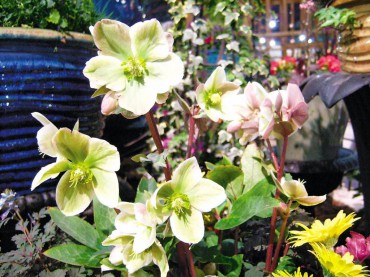
Beautyberry (Callicarpa bodinieri)
Just an OK shrub in the summer season, this plant becomes a fantastic shrub as it sheds its leaves, revealing porcelain-like purple berries all up and down the stems. Plant them where the berries are highlighted against a backdrop of evergreen.
Rose glow barberry (Berberis t. “Rose Glow”)
Give this plant time to mature unpruned and it will produce droplets of bright red berries along its graceful arching branches.
Snowberry (Symphoricarpos albus)
Our native snowberry has long, arching branches clustered with pure white berries. Encourage its natural habit to mingle with evergreen huckleberries (Vaccinium ovatum) for a good winter effect.
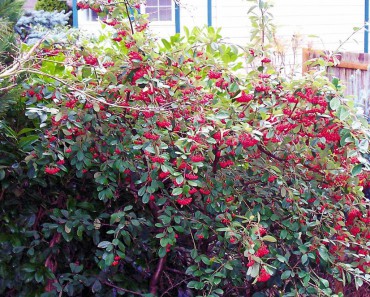
Viburnums
This is a popular category of evergreen and deciduous plants. Most produce flowers in season, followed by brilliant fall berries that cling until the birds steal them through winter. Varieties to look for: European cranberry bush (Viburnum opulus), Doublefile viburnum, (Viburnum p. tomentosum) and cranberry bush (Viburnum trilobum).
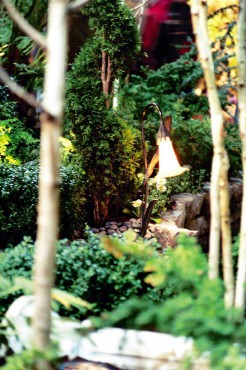
Red-twig dogwood (Cornus sp.)
Also in yellow and orange, the twigs become more vibrant in color as the weather gets cooler. The leaves drop and the shrubs fill in spaces like colorful winter centerpieces. Perfect in the midst of mixed planting beds or thickets along the fringes of native areas.
The combination of our famous Pacific Northwest evergreens and the addition of winter ornamentals give any garden longevity and variety in all seasons.
Now is the time to take a walk through the garden and look for places that need a pick-me-up for winter. Look at how faded summer plants can be joined by winter beauty and plan the landscape for a year-round show.




